

© Shipping Wonders of the World 2012-

Laying the Ocean Cables
Speedy communication by telegraph from continent to continent was first made possible by the specialized work of the cable-
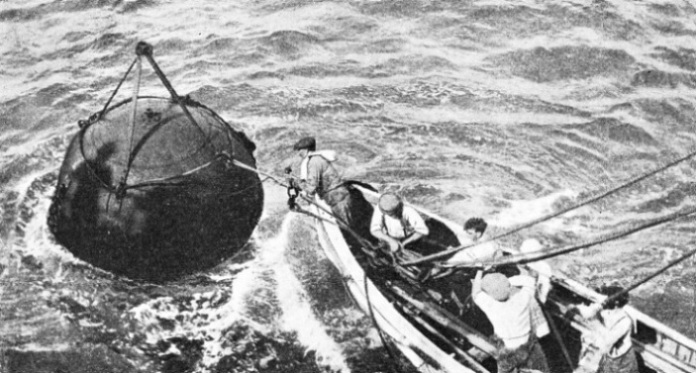
RECOVERING A MARK BUOY which is put down by a cable repair ship as soon as she reaches the position of a fault in the cable. The mark buoy may weigh anything from 7 cwt to 37 cwt, and is moored with mushroom anchors weighing from 3 cwt to 7 cwt.
THE laying of submarine telegraph cables across the wide oceans, whereby continent is linked with continent and far-
Before any cable is laid to-
Before the first great ocean cable was laid, the Atlantic cable between Ireland and America, a rough survey of the North Atlantic had been made by the American Lieutenant Maury. He discovered that the bed of the sea between Ireland and Newfoundland was so suitable for the reception of cable that he went so far as to say, “There is a plateau which seems to have been placed there especially for the purpose of holding a submarine telegraph cable and keeping it out of the way.”
Subsequent surveys with more advanced methods of taking soundings have revealed that the area of the Atlantic Ocean which actually received the name of Telegraph Plateau was, though flat enough, not quite so regular as had been thought. Within comp-
Various other surveys have discovered great mountain ranges and pits of almost incredible depth in various places. It is important that such depths as these should be discovered before any attempt is made to lay cable, for sudden changes place terrific strain upon a cable. Cable is not laid in the greatest depths because of the strain it would have to bear when being raised for repairs. The greatest depth at which cable has been laid so far is about 3,500 fathoms (21,000 feet).
During the preliminary survey the ship steams a zigzag course along the line of the proposed route, each arm of the zigzag being about five miles in length if the depth does not vary considerably, soundings being taken at the end and centre of each arm. One of the great advantages of the sonic, or echo, system of taking soundings (see page 1212) is that the ship does not have to be stopped while the sounding is taken, as is essential when line-
S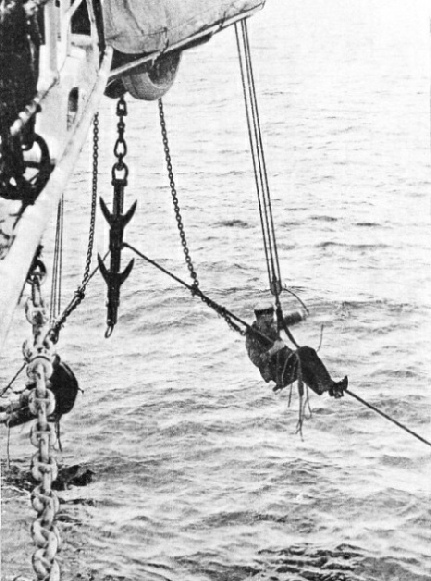 ometimes the sonic system cannot be used, for when it is necessary to know the exact nature of the sea-
ometimes the sonic system cannot be used, for when it is necessary to know the exact nature of the sea-
SECURING THE CABLE which the specially-
It is also important to know the temperature and pressure of the sea at any point where a proposed cable is to lie, for these factors have considerable bearing on the insulation resistance of the gutta-
When all the preliminary work has been done and the hundreds of miles of cable have been manufactured, the cable ship takes the cable on board into her storage tanks. This is not so simple a process as it may sound. In the ship are circular tanks, and into these the cable is carefully placed. The coiling is done by men sitting on stools, and the cable is brought past them by a man running round and round with it. This care is essential, for should a kink occur during subsequent paying-
While the cable is being loaded into the tanks note is taken of all splices, each section of the whole cable being recorded. As the resistance of each section may vary slightly, such a record helps in the location of a fault.
Cable is of three kinds -
Cables Fouled by Anchors
The laying of shore-
Hauling the end up the beach may be done in one of many ways. In tropical parts of the world there are usually crowds of natives only too anxious to lend a hand. At Sennen Cove, Land’s End, where many cable ends come in, horses are regularly used. In other places tractors have been used, and even railway locomotives.
Points as far as practicable from anchorages are chosen for sending in shore-
Cable ships have sheaves at the bows and stern, duplicate paying-
The cable comes out of the tank, passes over sheaves on the deck, round the drum of the paying-
One of the most interesting points about laying cable is that a certain percentage of slack has to be allowed. Cable is not laid down straight and taut. A percentage of slack is necessary to conform to the contour of the sea-
Tested in the Tank
During the whole period of laying, electric communication is maintained between the shore and the ship, messages being sent at regular intervals through the cable as it is being laid. This is a precaution against the putting down of many hundreds of miles after a fault has occurred, and should the electricians discover the slightest trouble, steps are immediately taken to deal with it.
By resistance tests the electricians can learn if a fault has developed in the unexpended portion of the cable lying in the tanks, and the fault can be remedied before the cable is paid out. In the unlikely event of a fault occurring in cable already laid but not far astern, the ship would pick up what, she has laid. Should the fault be found to be a long way astern, it would be necessary to cut the cable, buoy and sink the end, and return to the position of the fault, there to grapple, pick up, and effect a repair.
To-
When comparatively short distances are to be covered it is the usual practice to lay both shore-
The modern submarine cable rarely breaks down. Such troubles as it may be subject to are almost invariably due to outside causes. Shore-
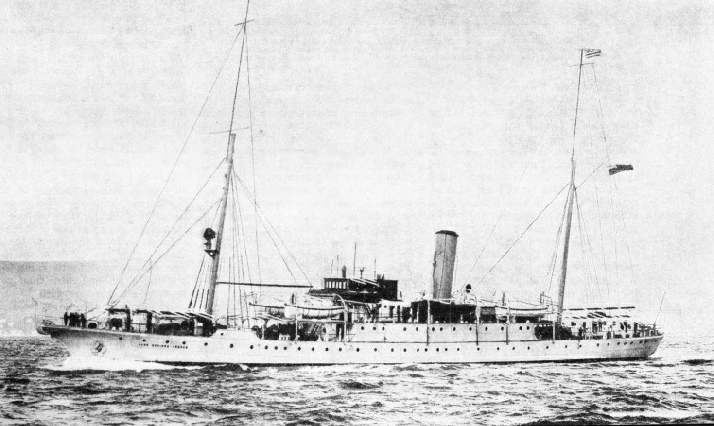
A TWIN-
The more frequent cause of injury to cables is fouling by anchors and trawls. Wherever possible cables are laid well away from anchorages, but even then, on the crowded coast of Great Britain injuries from anchors are fairly frequent. Rarely does a winter pass without the General Post Office cable repair ships Monarch and Alert having to go to sea in a hurry to repair cables injured in the English Channel.
Methods of trawling have improved, but the cable companies have to protect their property by paying trawler owners for loss of gear cut away rather than have shipmasters free themselves from entanglement by cutting away the cable.
In the history of the submarine telegraph the greatest enemy to the cable has proved to be the smallest of animals, namely, the marine borers, various minute animals grouped together under the general name of teredo. These creatures are fond of gutta-
Now, however, means have been found for protecting the cable by wrapping the core with a tape composed of an alloy through which the marine borer cannot penetrate, so that faults from this cause are not nearly as frequent as they were.
The breakdown of a cable is a serious business, for in addition to the expense to the owning companies or the Post Office of sending a ship to sea to effect a repair, there is the loss of revenue by interruption in traffic to be considered. Therefore the sooner a fault can be located and repaired the better for all concerned.
Special Types of Grapnel
To the landsman unacquainted with telegraphy it is frequently a source of wonder that the exact position of a fault can be estimated, even though the point of fault is hundreds of miles out in the ocean. The resistance of every section of a cable is known. By means of artificial resistances, which can be measured, an electrical balance is established between the artificial resistance and the resistance of the cable up to the fault. It being known in the cable house on shore that the resistance of the cable is, say, two ohms to the mile, when the artificial resistance establishes a balance at 2,730 ohms it follows that the fault will be found 1,365 miles from the cable house.
Cable companies have detailed charts of the positions of their cables, and thus it is possible within a few minutes to establish the position in the ocean of the fault, and to that point the repair ship steams at speed.
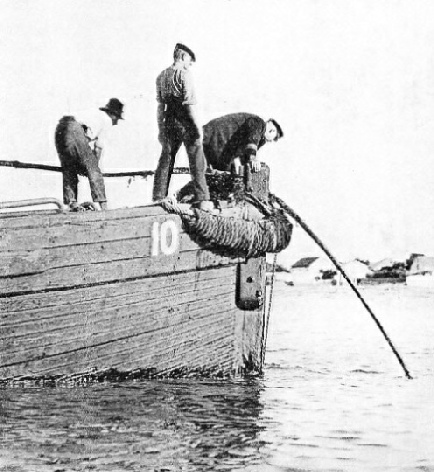 On arrival the repair ship’s first operation is to put down a mark buoy, which may weigh anything between 7 and 37 cwt, according to the depth of water. Mark buoys are moored with mushroom anchors from 3 to 7 cwt in weight, and several may have to be used where water is deep or where there is a strong current.
On arrival the repair ship’s first operation is to put down a mark buoy, which may weigh anything between 7 and 37 cwt, according to the depth of water. Mark buoys are moored with mushroom anchors from 3 to 7 cwt in weight, and several may have to be used where water is deep or where there is a strong current.
THE SHORE END of a submarine cable is generally laid from a lighter which is towed out to sea as the cable is paid out. Near the shore the cable receives comparatively rough treatment; thus shore-
Having put down the mark buoy, the ship establishes its position by means of observations, using ordinary navigational methods for this purpose. She then steams to a distance of about three miles or so from the line of the cable according to the depth of water and proceeds to grapple for the cable, using a grapnel, chain and wire rope with a breaking strain of between 22 and 30 tons. Grapnels are of various kinds according to the nature of the bottom, for a type suitable for use where the cable may be buried in ooze is not suitable on a rocky bottom and would soon be broken.
When a repair ship is seeking the end of a cable which has been completely severed she may grapple it so near the break that the end slips through the grapnel. On the other hand, if she hooks it at too great a distance the cable may break through its own weight. To deal with this situation the late Mr. F. R. Lucas introduced a highly ingenious type of grapnel which will hold the cable and cut it.
Whatever type of grapnel is used, the rope to which it is attached is paid out over the bow sheaves of the ship and the strain is registered on the dynamometer. By watching this instrument it is possible to tell, by the sudden increase in strain, when the cable has been hooked. The dynamometer is also useful for telling when the grapnel has reached the bottom.
In the days before the invention of the cutting-
When at last the cable has been found the grapnel is hove up by the drum of the picking-
Th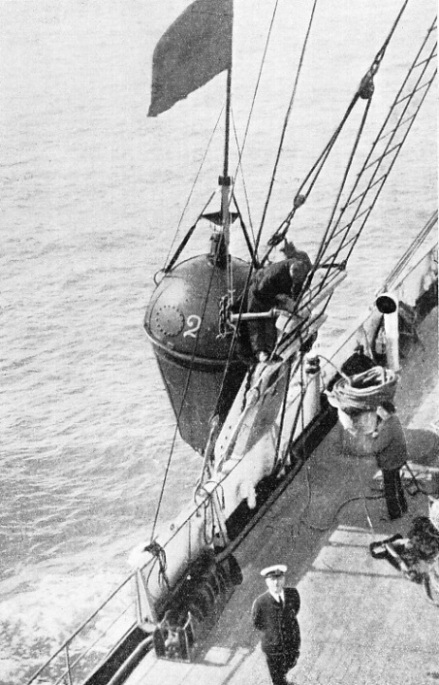 e electricians now take charge, and their first job is to discover on which side of the cut the fault lies. It may be that the fault lies at some distance -
e electricians now take charge, and their first job is to discover on which side of the cut the fault lies. It may be that the fault lies at some distance -
BEFORE REPAIRING A FAULT in a submarine cable, the repair ship marks with a special buoy the position of the fault, which has been located by the electrical engineers ashore. The buoy, with its flag to make it conspicuous, then acts as a centre for the ship’s grappling operations, carried out by means of special grapnels that pick up the cable from the ocean bed.
Further tests having proved that all is in order with the new portion, the ship returns to the cable buoy, picks up the other end, a further splice is made, and the cable is now repaired and in working order again. In making a joint it has to be seen that no air bubbles have become imprisoned in the gutta-
In certain spots, as, for instance, San Francisco Bay or Valentia Harbour, Ireland, there are many cables and grappling is a delicate operation because of the risk of disturbing the wrong cable. To avoid this risk divers are sent down to untangle the cables and repairs are carried out in barges.
Within recent times there has been brought into use an ingenious device for preventing a repair ship picking up the wrong cable in shallow water and where many shore-
By using it, a working cable can be distinguished from a “dead” one, and when several cables have been brought to the surface, by merely placing a small frame-
You can read about “Cable Ships at Work”, “The Famous Great Eastern” and “The Faraday” on this website.
You can read more about The First Atlantic Cable in Wonders of World Engineering.